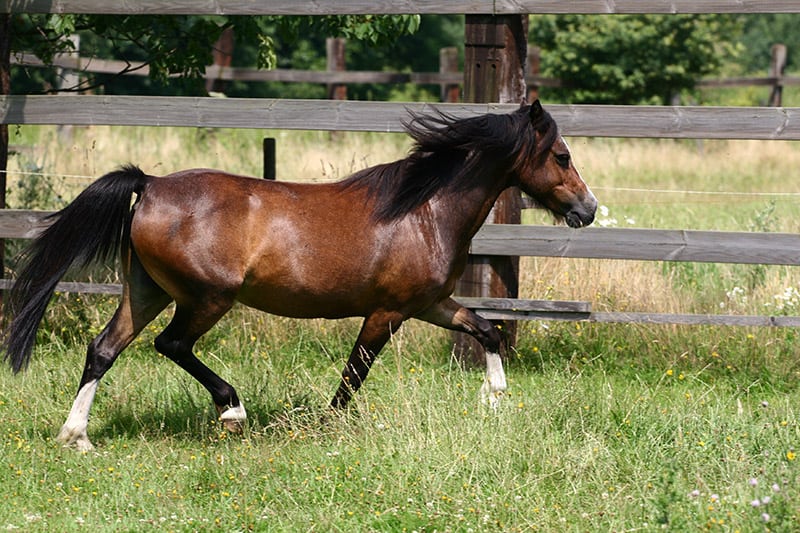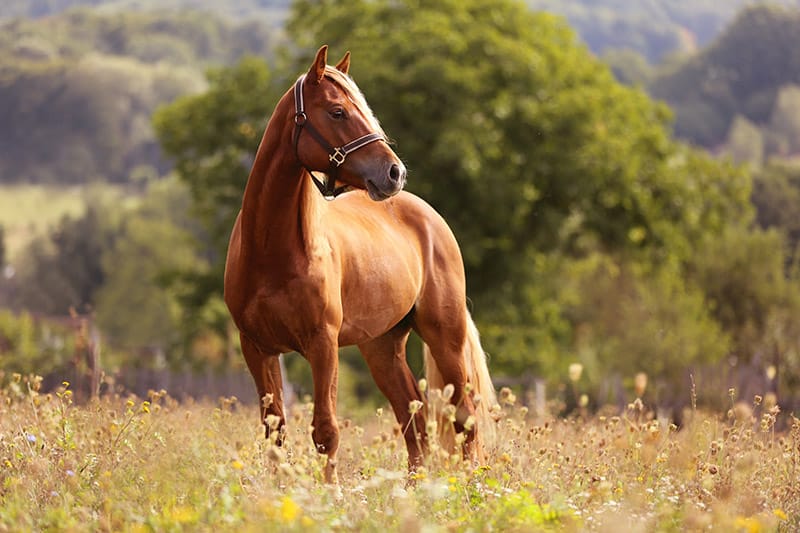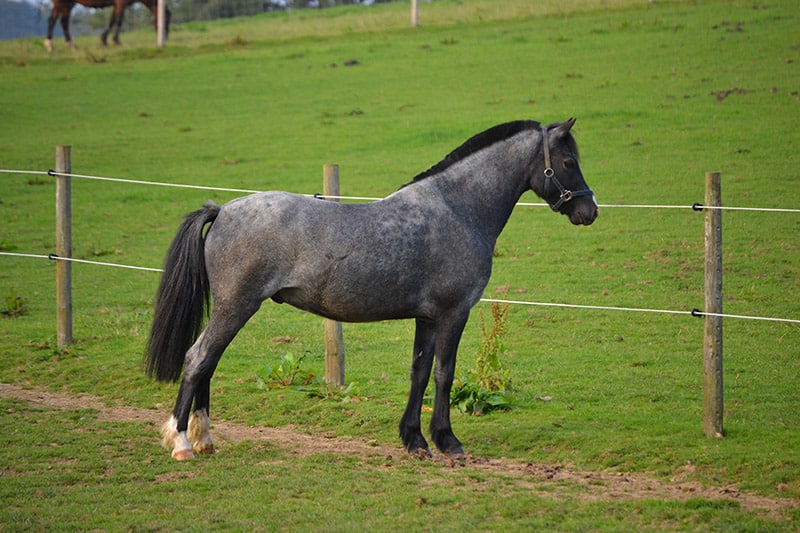A popular breed, the Pony of the Americas is one of the newer pony breeds!
The Pony of the Americas is an ideal riding horse for children due to its small stature, athleticism, and gentle personality. For young equestrian riders, who are too big for the smaller ponies yet not quite ready for a full sized horse, the Pony of the Americas is a perfect match. The growing popularity of the Pony of the Americas lends itself to being a breed for children to ride and show. It is a pony breed with a good appearance, speed, and stamina. Yet at the same time this breed is less intimidating for children. Its size is more closely matched to the young rider, making it easier to train, handle and ride, and also easier to groom.
The development of the Pony of the Americas (commonly called the POA) started in 1954. It is a distinctive breed with the attractive coloration of the Appaloosa Horse, a gentle disposition, durability and intelligence. It is an excellent choice both for riding or driving in competition, as well as for pleasure. Though primarily developed for young riders, adults can also show the POA’s in halter and pleasure driving competitions. These easy-going and friendly ponies make excellent companions for children and adults alike.
Scientific Classification
| Kingdom: | Animalia |
| Phylum: | Chordata |
| Class: | Mammalia |
| Order: | Perissodactyla |
| Family: | Equidae |
| Genus: | Equus |
| Species: | caballus |
Horse Breeds
The Pony of the Americas is one of the pony breeds. Ponies are generally considered to be 14.2 hands or smaller at maturity, however, this is a general rule with many exceptions. Pony breeds have a slightly different appearance than the light horse breeds. They usually have thicker manes, tails and coats. They are proportionately shorter-legged and rounder through the barrel. They have somewhat shorter and thicker necks and wider, stronger bones.
Ponies are well known for their superior intelligence and with good horse training, more tractable temperaments. Many of the pony breeds evolved where there was inferior nutrition and which resulted in a smaller breed. Ponies generally require less diligence in their care and often tend to be more independent than the other types of horses.
Well-trained ponies can make wonderful mounts for children. Their small sizes make them less intimidating and are more closely matched to a child’s size and strength. They do well in many disciplines including driving, hunters on the flat and over fences, western driving classes, and pleasure riding. They can also show in dressage, equitation, show jumping, and other events; with top ponies even being competitive against full-sized horses.

Horse Backgrounds
The story of the Pony of the Americas began in 1954. Les Boomhower, a Shetland pony breeder, bought an Arabian/Appaloosa mare that had accidentally been bred to a Shetland stallion. He bought the mare after she had her foal, which was white with black splotches. The foal had a black pattern over his flank that looked like a hand, causing Les to name him Black Hand.
Les was quite impressed with the colt. He decided to form a Pony of the Americas Club (POAC) with some of his fellow Shetland breeders to continue breeding the Appaloosa/Arabian/Shetland cross. They set strict standards of physical attributes for a pony to be registered with the POAC. The pony had to be between the height limits of 11 to 13 hands (44 to 52 inches). The head was to be small and dished as the Arab; the body was to be muscled as the Quarter Horse; and the coloring had to be Appaloosa, visible at 40 feet. This was to be a breed for children to ride and show so these equines also needed to be gentle and easy to train. Adults could only show the animals at halter or with a cart.
The original POAC expanded to include state clubs, regional shows and sales, a world class international show, and a world championship show. The breed registry has increased from #1 Black Hand in 1954 to over 40,000 registered POAs in 1996. Only children under 18 are allowed to show in the majority of the riding classes. Adults can show in the halter classes and in ‘19 and over’ classes on 2, 3, and 4 year old POAs in training.
Besides the usual high point standings, the breed added Register of Merit Awards for halter, performance, and gaming. A POA earning all three receives the highest of all awards, Supreme Champion. POAs and POAC members can also be inducted into the POA Hall of Fame, which began in 1990.
The height restriction for POAs has been increased several times. Currently POAs must be between 11.2 and 14 hands (46 to 56 inches). This change can be attributed to a reduction in the use of the Shetland for POA breeding programs starting in the early 1960’s. Breeders prefer to breed POAs with larger, more athletic breeds such the Arabian, Appaloosa, Thoroughbred, American Mustang, and Welsh pony. Interbreeding with these breeds help to obtain a “little horse” look and increases the athleticism and stamina of the POA.
Description
The Pony of the Americas Club (POAC) sets strict guidelines for the physical appearance and attributes of a registered POA. The POA should generally have the head shape of the Arabian, the muscular body of the Quarter Horse, and the coloring of an Appaloosa. The current height requirement is that POAs must be between 46 and 56 inches.
A POA should be well-proportioned and should lean toward the build of a small horse, not a pony. The face is slightly dished, owing to the POA’s Arabian ancestry, with a wide forehead. The neck should be fairly fine (not too thick) and in proportion to the body. The shoulder and hindquarters should be muscular, and the legs should be in good proportion.
The most defining characteristic of POAs is the Appaloosa-like coat pattern, and includes:
- Blanket Pattern: One of the most common patterns is the blanket pattern, where the pony has white over the hips and on the rump with G-shaped spots mixed in.
- Snow-capped Pattern: A variation on the Blanket Pattern is the absence of the spots, giving the horse a solid white on the rump, which is known as snow-capped.
- Leopard Pattern: POAs can also have an all-over spotted pattern that is commonly referred to as a leopard pattern.
- Roan: They can also be roan, which is a solid color with white hairs mixed in.
POAs have mottled skin (pigmented and un-pigmented patches) in the areas where skin shows, which is on the muzzle, the sheath or udder, and the anus or vulva. The mottled skin on the muzzle is speckled and in the genital areas it is more patchy. POAs also have bold and clearly defined vertical stripes on their hooves.
A registered POA must have white sclera in at least one eye. The sclera is the visible part of the eye outside the iris (the colored part of the eye). In most horses this area is brown, and white is only visible when they eyelid is pushed back. In POAs, white must be visible when the eye is open normally.

Horse Care and Feeding
The Pony of the Americas are fairly easy keepers. POAs, like any horse with white areas, may require extra grooming and more frequent bathing to keep them looking white and flashy.
Horse Training and Activities
Pony of the Americas are a great mount for children doing any type of riding. They have a gentle disposition and are durable intelligent pony breeds making them easy to train for a variety of disciplines. They are good for trail and endurance riding, halter, performance and gaming, as well as ranch work and hunting.
Common Health Problems
Similar to the Appaloosa, Pony of the Americas can be afflicted by congenital stationary night blindness (CSNB) which causes them to have virtually no night vision. The disease is thought to be caused by the LP gene that creates certain Appaloosa-like coat patterns. Any pony that is homozygous for the LP gene can be afflicted. The disease is present at birth and is non-progressive. Clinical signs are confusion, spookiness, and reluctance to move in places with low lighting. The only way to test for CSNB is to have a veterinary ophthalmologist perform an ERG (electroretinogram) vision test.
POAs can also be more prone to equine recurrent uveitis than other breeds. This is an immune inflammatory response of the uveal tract of the eye. Clinical signs are puffy, watery eyes, red blood vessels on the sides of the eye and lids, and squinting. It can cause damage to the retina if it goes untreated.
The pink skin that is exposed on a POA, especially on the muzzle, is susceptible to sunburn so applying sun block to these areas is advisable.

Availability
Pony of the Americas are fairly available throughout the United States and can be found at an affordable price. The Pony of the Americas Club (POAC) website http://www.poac.org/, maintains a list sellers.
Featured Image Credit: Daisy Shakespeare, Shutterstock
